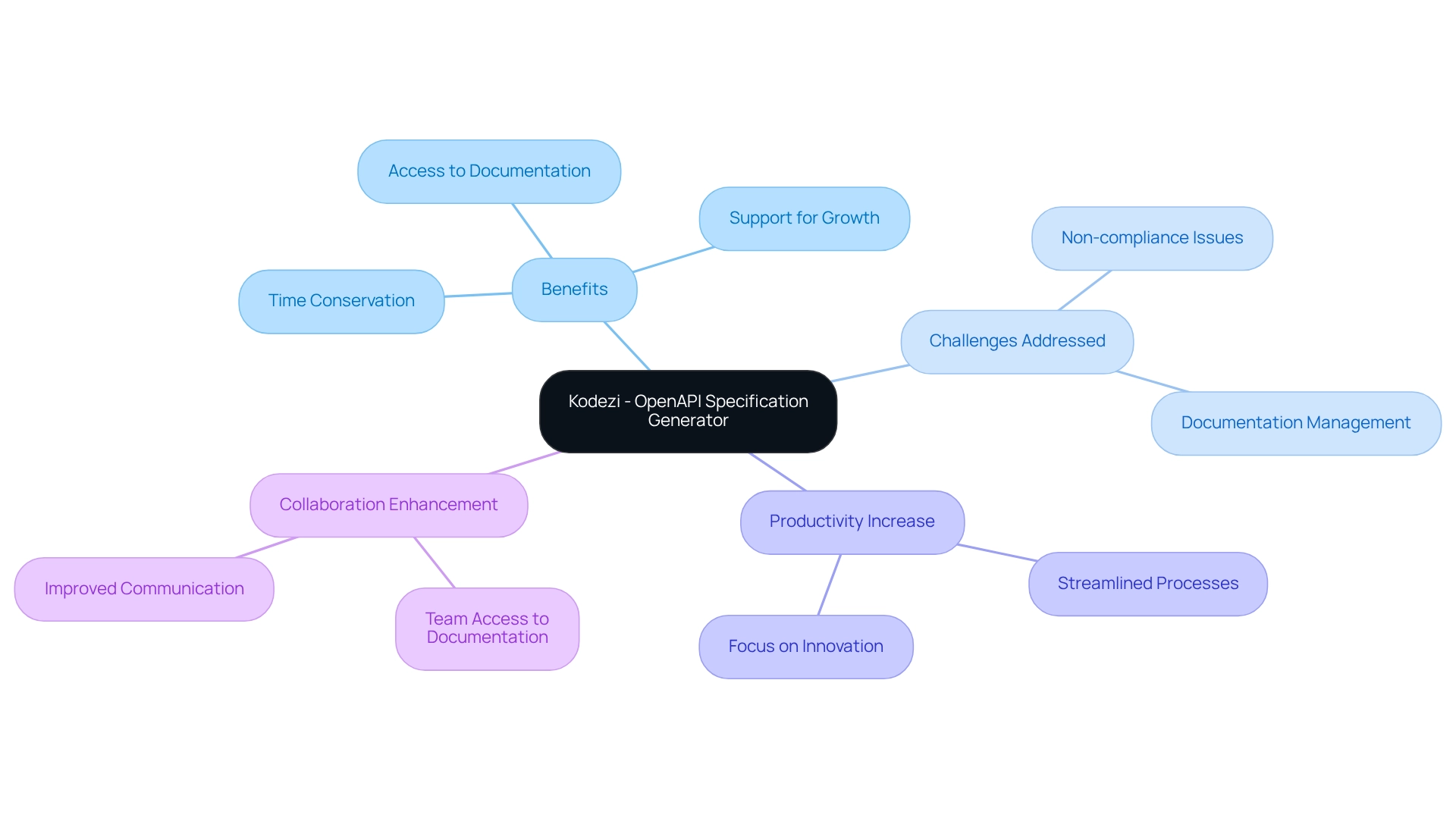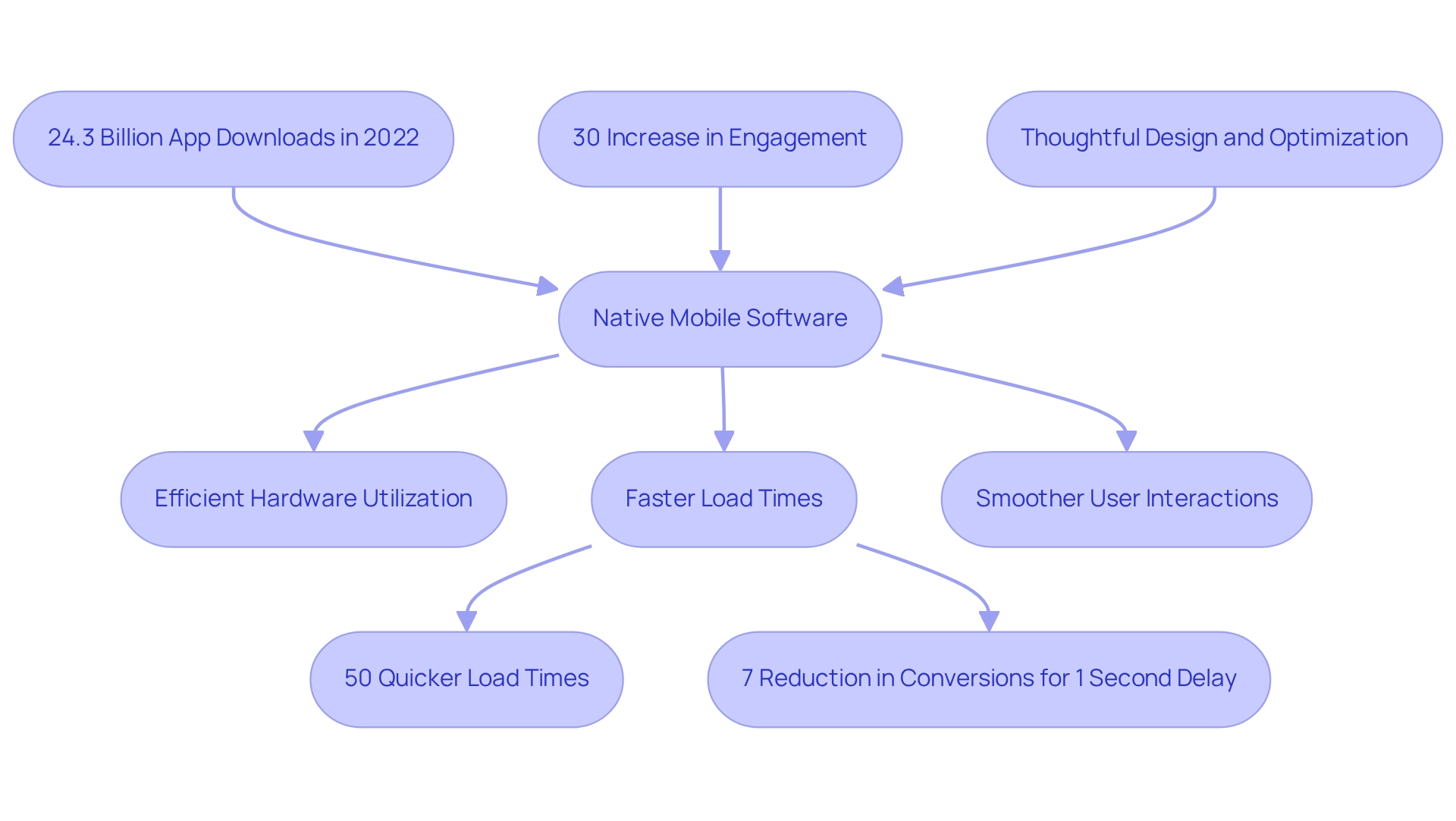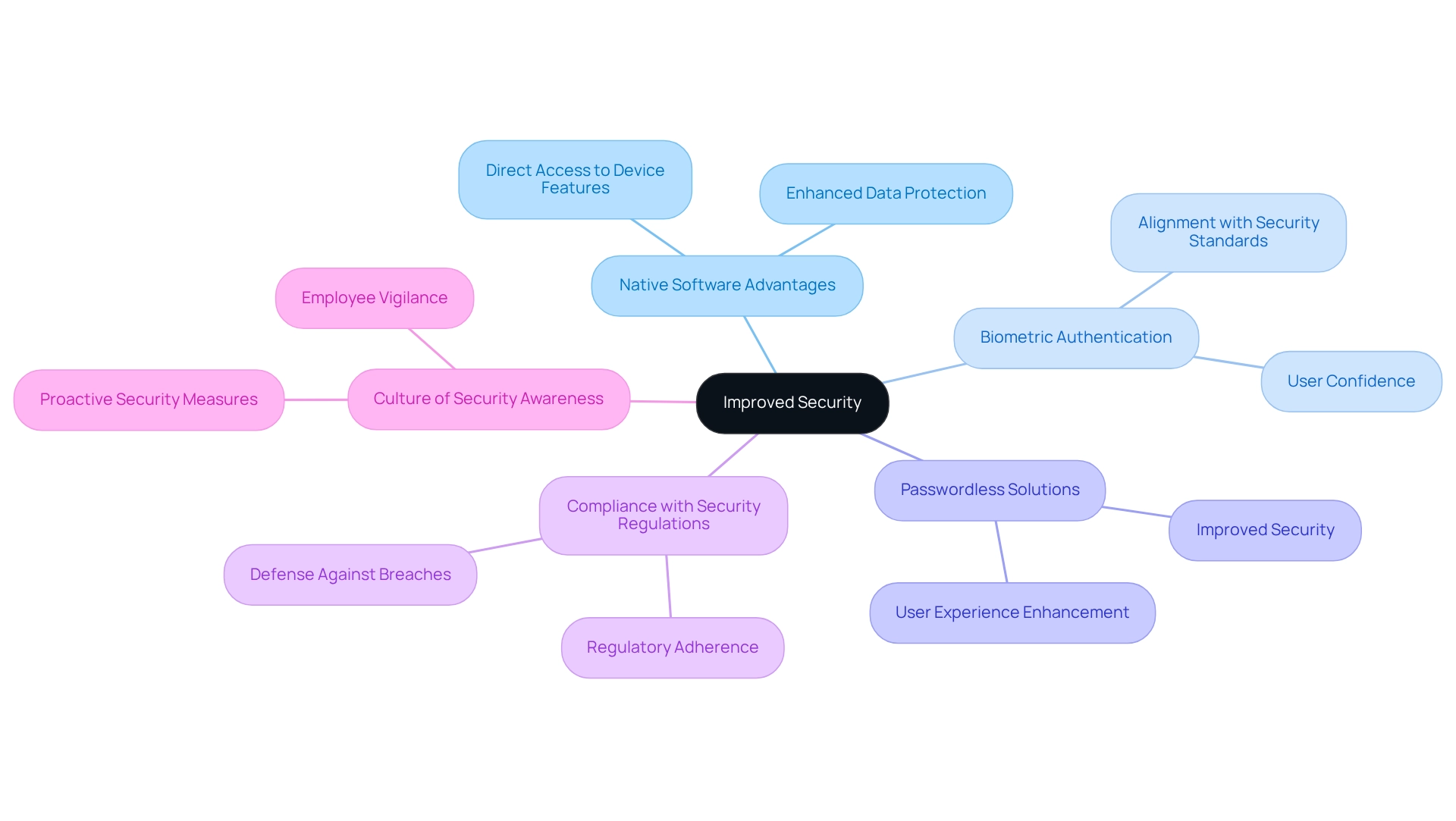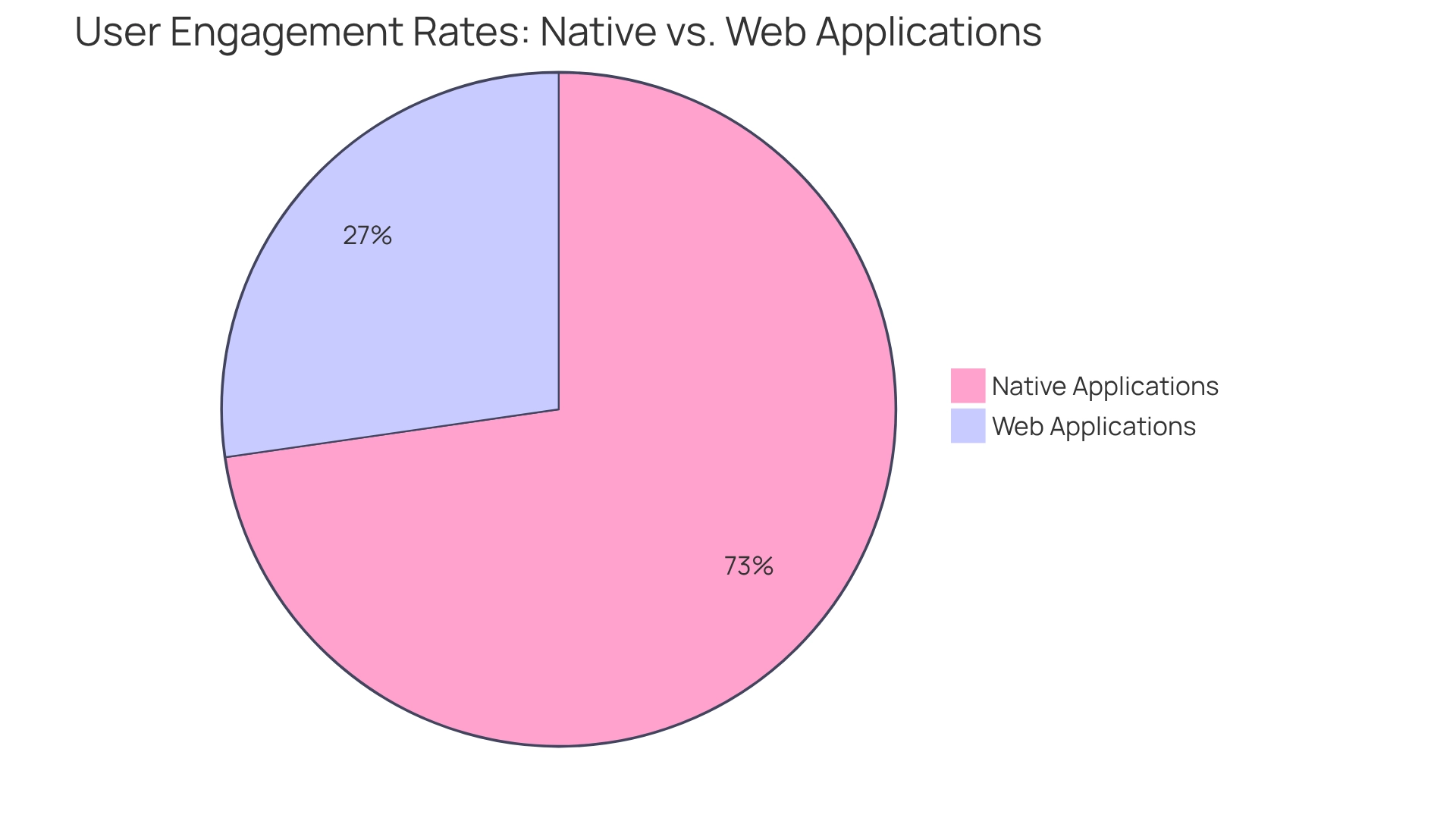Overview
The article titled "10 Benefits of Native Mobile Dev for Enhanced App Performance" presents a compelling overview of the advantages that native mobile development brings to application performance. It captures attention by addressing common challenges developers face and introduces the key benefits of:
- Faster load times
- Improved user experience
- Enhanced security
- Better compliance with app store guidelines
Furthermore, it supports these claims with statistics and case studies that illustrate how native apps consistently outperform cross-platform alternatives in user engagement and satisfaction. This informative piece encourages readers to consider the significant impact of native development on their projects.
Introduction
In the fast-evolving landscape of mobile app development, developers face numerous coding challenges that can hinder their progress. The advantages of native applications are becoming increasingly undeniable. With capabilities that extend beyond mere functionality, native apps offer enhanced performance, security, and user experience, all while ensuring compliance with platform-specific guidelines. Furthermore, as developers strive to meet rising user expectations and navigate complex market demands, tools like Kodezi emerge as essential allies. Kodezi streamlines the development process, fostering innovation and efficiency.
This article delves into the myriad benefits of native mobile development, exploring how it not only enhances user engagement but also positions developers for future growth in an industry poised for continuous evolution. By leveraging Kodezi, developers can significantly improve productivity and code quality, ultimately leading to a more satisfying development experience. Are you ready to explore the tools available on this platform and elevate your coding practices?
Kodezi | Professional OpenAPI Specification Generator - AI Dev-Tool: Streamline Your Native App Development Process
Developers often face significant challenges when it comes to managing API documentation. Kodezi stands out as a robust OpenAPI Specification generator that automates this process, allowing programmers to concentrate on crafting high-quality applications. By incorporating Kodezi into their development workflows, teams can streamline their processes, ensuring that their native mobile dev projects are built on a foundation of meticulously documented APIs. This automation conserves valuable time and fosters improved collaboration among team members, as everyone can easily access the latest documentation.
The importance of automated API documentation is underscored by the staggering statistic that 158,000 programmer accounts were banned in 2024 due to non-compliance with documentation standards. This highlights the critical need for well-maintained APIs. Companies like M1 Finance have demonstrated the significance of cohesive testing strategies, which include robust API documentation, to support their ambitious growth and product development goals.
As the demand for efficient native mobile dev continues to rise, leveraging tools like Kodezi becomes essential. The OpenAPI Specification not only boosts programmer productivity but also aligns with the latest trends in API documentation automation, ensuring that teams can adapt swiftly to evolving project requirements. With Kodezi, programmers can streamline the documentation process, enabling them to focus on innovation and providing outstanding user experiences.
Kodezi CLI serves as a versatile tool for teams, allowing them to auto-heal codebases, enhance programming productivity, and facilitate effortless deployment as part of their existing release processes. As Tabarak Paracha mentioned, "We are thrilled to reveal the inclusion of the Ionic Capacitor plugin to our roster of supported SDKs," emphasizing Kodezi's commitment to improving its features and assisting creators in their projects.

Enhanced Performance: Achieve Faster Load Times and Smooth User Experiences
Native mobile software is specifically designed to operate directly on a device's operating system, enabling efficient utilization of hardware resources. This architecture results in significantly faster load times and smoother interactions compared to cross-platform alternatives. Recent studies indicate that native applications can achieve load times up to 50% quicker than their cross-platform counterparts, enhancing user satisfaction and retention.
By optimizing code and leveraging native APIs, developers can ensure their applications respond swiftly to user inputs. This responsiveness is critical; research shows that even a one-second delay in load time can lead to a 7% reduction in conversions. Furthermore, the iOS App Store reported 24.3 billion app downloads in 2022, marking an increase of 600 million downloads from the previous year, underscoring the growing demand for high-performance applications.
Expert insights suggest that while developers often chase the latest technologies, focusing on thoughtful design and optimization is essential for achieving superior performance. As C.A.R. Hoare aptly noted, effective software design should prioritize simplicity to avoid deficiencies. This principle is especially relevant in native mobile dev, where streamlined code can enhance performance.
In practical terms, case studies demonstrate that companies utilizing native mobile dev have experienced substantial improvements in app performance. For instance, a leading e-commerce platform reported a 30% increase in engagement after transitioning from a cross-platform to a native app, primarily due to faster load times and an enhanced user experience. Nick Foster reflects on the emotional journey of programming projects, emphasizing that programmers' experiences can significantly impact performance outcomes.
Overall, native mobile dev applications not only enhance performance but also greatly improve user experience, making them a preferred choice for developers who aim to deliver high-quality software.

Improved Security: Leverage Device-Specific Features for Robust Protection
Native software advantages stem from direct access to device-specific security features, including biometric authentication and secure storage. This allows developers to implement advanced security measures that effectively protect data, surpassing the capabilities of cross-platform solutions. The necessity for enhanced security practices is highlighted by the millions of malicious mobile apps blocked daily, underscoring the importance of robust security measures.
Implementing biometric authentication aligns with current security standards while fostering user confidence in the protection of personal information. As Patrick Harding, Chief Product Architect at Ping Identity, warns, traditional password systems are increasingly regarded as liabilities amid sophisticated cyber threats. This shift emphasizes the benefits of passwordless solutions, which can be seamlessly integrated into native software.
Moreover, the security advantages of native mobile software extend beyond authentication. By leveraging device-specific features, developers can create software that complies with security regulations and offers a strong defense against potential breaches. This is particularly crucial as organizations are encouraged to cultivate a culture of security awareness among employees, ensuring vigilance against emerging threats. As we look ahead to 2025, the landscape of mobile app security continues to evolve, with native mobile dev playing a key role in adopting innovative security features. John McAfee notes that hackers rarely possess complete knowledge of a target's technology stack, highlighting the unpredictability of security threats. By utilizing the latest technologies and fostering a culture of security awareness, developers can significantly enhance the security posture of their software, ensuring data remains protected against emerging threats. Additionally, Eric Raymond argues that the ability to breach security does not define a hacker, further emphasizing the necessity for proactive security measures in app development.

Superior User Experience: Deliver Intuitive and Responsive Interfaces
Native mobile dev applications empower creators to design interfaces that align with platform-specific design guidelines, resulting in a more intuitive experience. By leveraging native mobile dev components, developers create apps that resonate with users, thereby enhancing usability and overall satisfaction. This meticulous focus on design detail not only boosts engagement but also fosters positive reviews and recommendations.
For example, Sworkit, a leading fitness application, utilized Ionic to unify its codebase, significantly improving the experience for millions. Furthermore, advanced code optimization features aid developers in addressing bottlenecks and security issues, further enhancing app performance.
Statistics reveal that customizing push notifications can elevate reaction rates by as much as 400%, underscoring the importance of personalized experiences. As a User Experience Specialist noted, 'A poor UX design can lead to low audience retention rates, negative feedback, and a decline in downloads and overall app growth.'
As we approach 2025, the relevance of adhering to platform-specific design guidelines in native mobile dev becomes increasingly clear, as these guidelines are crucial for addressing users' short attention spans and limited reading capabilities. This focus on visual hierarchy ultimately drives app growth and retention, making it essential for creators who aim to boost productivity and deliver better results for users.
Full Access to Device Features: Utilize Camera, GPS, and Other Hardware
A key advantage of native mobile dev lies in its seamless access to a device's hardware features, such as the camera, GPS, and accelerometer. This straightforward integration empowers programmers to design software that harnesses unique capabilities, including location-based services and augmented reality experiences, which significantly enhance user engagement.
For example, location-based marketing not only boosts customer interaction but also increases foot traffic; statistics reveal that 84% of companies employing this strategy report improved customer engagement. Furthermore, location-based ads have demonstrated effectiveness, being 20 times more impactful than standard banner ads, underscoring the critical role of relevance and timeliness in app interactions. As one marketer aptly noted, 'Location-based ads are 20 times more effective than standard banner ads.'
By incorporating GPS and camera functionalities, developers can craft immersive experiences that not only align with user expectations but also foster higher retention rates and satisfaction. To maximize the impact of these features, it is essential to create compelling content and utilize real-time location data. As mobile software increasingly relies on these hardware capabilities, the potential for innovative solutions continues to grow, making native mobile dev an appealing choice for enhancing app performance.
Better App Store Compliance: Meet Platform-Specific Guidelines with Ease
Native applications are meticulously crafted for their specific platforms, facilitating adherence to app store guidelines. This alignment with established design and functionality standards set forth by Apple and Google significantly mitigates the risk of rejection during the app review process. Consequently, this proactive approach conserves valuable time and guarantees that the app reaches its intended audience without unnecessary delays. In fact, statistics reveal that 49% of users expect apps to load within 2-5 seconds, underscoring the importance of a smooth launch.
Furthermore, recent updates to the App Store Review Guidelines and Agreements for Creators emphasize the changing compliance landscape, making it essential for creators to remain informed. As Apple states, "Learn how to implement new Apple technologies, explore UI design principles, improve your App Store presence, and much more." A significant case study from Vietnam illustrates this point: as of February 4, 2025, the Vietnamese Ministry of Information and Communications requires that games must be licensed to stay accessible on the App Store, necessitating creators to present their license number on the app's product page. Such regulations exemplify the critical nature of compliance in native mobile dev, reinforcing the need for developers to effectively navigate platform-specific guidelines.
This compliance not only guarantees adherence to regulations but also enhances app visibility and cultivates trust among users.
Scalability: Build Apps That Grow with Your User Base
Native mobile dev applications are designed for scalability, utilizing the full potential of device hardware and operating systems. This design approach enables developers to create applications that effectively manage increased demands and interactions without sacrificing performance. As customer bases expand, native applications maintain a high-quality user experience, positioning them as a sustainable choice for businesses. Did you know that 49% of individuals expect apps to load within 2-5 seconds? This statistic underscores the critical importance of performance under load. Native apps excel in meeting these expectations by optimizing resource usage and improving loading speeds.
Furthermore, the native mobile dev industry is anticipated to grow at an annual rate of 8.58% from 2022 to 2027, reflecting the rising demand for innovative and scalable solutions. Case studies, such as the KFC mobile application, illustrate that focusing on scalability can lead to significant improvements in engagement and conversion rates. Neeraj Tiwari, Director of Digital Engineering, remarked, "This led to significant improvements in user engagement and digital revenue. Ultimately, we saw a 22% increase in conversion rates and a 60% rise in repeat orders within the KFC mobile app."
In addition, with 85% of U.S. mobile shoppers preferring apps over mobile sites, it is clear that prioritizing scalability in native mobile dev not only addresses current needs but also prepares developers for future growth. Are you ready to enhance your mobile application strategy? Emphasizing scalability can be the key to unlocking greater user satisfaction and business success.
Easier Debugging and Maintenance: Reduce Long-Term Development Costs
Developers often face significant challenges when debugging their code. Native mobile dev applications leverage powerful debugging tools inherent to their development environments, including Xcode for iOS and Android Studio for Android. These tools significantly enhance programmers' ability to identify and resolve issues quickly, which is essential for maintaining app functionality and performance.
Enter Kodezi CLI: a solution that empowers B2B engineering teams to autonomously enhance their codebases by:
- Instantly identifying and fixing issues
- Providing detailed explanations and insights into what went wrong
- Ensuring compliance with the latest security best practices
This versatility allows teams to swiftly AutoHeal codebases, ultimately boosting programming productivity and refining the debugging process.
By streamlining the debugging process, programmers can significantly reduce the time and costs associated with app maintenance. For instance, updating performance aspects of an app can incur costs ranging from $1,000 to $2,000, highlighting the financial advantages of efficient debugging. Furthermore, expert insights suggest that focusing on effective debugging not only simplifies maintenance but also contributes to lower long-term development costs.
Ron Jeffries emphasizes the importance of measuring performance rather than speculating about system behavior, reinforcing the critical role of effective debugging in maintaining app performance. This proactive approach ensures that native mobile dev practices keep native apps competitive and up-to-date, fostering a more sustainable development lifecycle.
This statement underscores that effective debugging, supported by tools like Kodezi CLI, is integral to a broader strategy for creating valuable products. Additionally, Pamela Zave's perspective on managing complexity in software engineering resonates with the theme of utilizing debugging tools to simplify and enhance the development process. By concentrating on these elements, creators can ensure that their native mobile dev is both functional and economical over time.
For those eager to get started, Kodezi CLI offers a 5-minute quickstart and a demo to showcase its capabilities.
Faster Development Cycles: Accelerate Your Time to Market
Coding challenges can significantly hinder development cycles, especially when developers face issues like excessive memory usage and reliance on third-party plugins. These common pitfalls can be effectively addressed through native mobile dev, which accelerates coding processes by leveraging platform-specific libraries and tools. By utilizing resources such as Flutter or Xamarin, programmers can enhance productivity, with reported increases of up to 25%, particularly when working within multiskilled teams. This not only helps in meeting the ever-evolving user expectations but also aligns with market demands.
Furthermore, integrating tools like Kodezi CLI can streamline this process. Kodezi's AutoHeal feature automates code troubleshooting, allowing programmers to quickly identify and resolve codebase problems. This efficiency not only optimizes performance but also ensures adherence to the latest security best practices and coding standards. For instance, striving for an app that consumes no more than 5% battery per hour during active usage serves as a benchmark for performance, emphasizing the necessity of efficient coding practices.
In addition, a notable case study is TuneGO, a music distribution platform that effectively utilized native mobile dev to cultivate a vibrant community for artists and fans. Their approach not only enhanced user engagement but also demonstrated how efficient development cycles can lead to innovative solutions in the market. By focusing on strategies like the use of Kodezi CLI for automated improvements, developers can significantly accelerate their time to market, ensuring their software meets the high standards expected by consumers today. So, why not explore the tools available on Kodezi's platform to elevate your coding practices and enhance your productivity?

Higher Engagement Rates: Foster Stronger Connections with Users
Native mobile dev significantly boosts engagement rates by delivering a seamless and responsive experience. By harnessing device capabilities and adhering to platform-specific design principles, native mobile devs can create applications that resonate with users, leading to more frequent and meaningful interactions. This heightened engagement in native mobile dev not only enhances satisfaction but also cultivates long-term loyalty and retention.
For instance, studies show that native applications can achieve engagement rates as high as 80%, compared to only 30% for web applications. Furthermore, the mobile app industry is currently experiencing a transformative shift towards native mobile dev, driven by advanced technologies and evolving consumer behaviors. This makes it essential for native mobile devs to optimize their strategies for both Android and iOS platforms.
A balanced approach can maximize reach and revenue potential, as evidenced by the success of popular titles like Honor of Kings, which generated over $24 million in revenue in September 2022. By focusing on responsive design and user-centric features, native mobile dev fosters deeper connections and ensures that users remain loyal and engaged over time.
To leverage these trends effectively, consider engaging with Kodezi's offerings—Get Started for Free or request a Demo to see how our tools can enhance your mobile development strategy. As one expert noted, "By aligning your marketing strategy with these trends, you can improve visibility, optimize your acquisition funnel, and ensure your brand capitalizes on the ongoing growth of native mobile dev.

Conclusion
The advantages of native mobile application development are evident and persuasive, equipping developers to satisfy the growing expectations of users and the market. By utilizing tools like Kodezi, developers can optimize their workflows, automate API documentation, and boost overall productivity. This results in quicker load times, enhanced user experiences, and improved security—essential components that greatly affect user satisfaction and retention.
Furthermore, native apps offer complete access to device features, allowing developers to craft innovative, captivating experiences that resonate with users. Adhering to platform-specific guidelines ensures that applications not only reach their target audience but do so in a manner that aligns with evolving compliance standards. The scalability inherent in native development facilitates growth, enabling applications to adjust as user bases expand without compromising performance.
As the mobile app landscape continues to change, the focus on accelerated development cycles and simplified debugging will be crucial. By leveraging the capabilities of native development and tools like Kodezi, developers can lower long-term costs and hasten their time to market. This proactive strategy not only encourages innovation but also positions developers for sustained success in an increasingly competitive environment.
In conclusion, adopting native mobile development is not merely a strategic decision; it is vital for delivering high-quality applications that fulfill today’s user expectations. The combination of enhanced performance, security, and user experience, along with the efficiency gains from automation tools, establishes a foundation for developers to excel in a landscape ripe for continuous evolution.
Frequently Asked Questions
What challenges do developers face with API documentation?
Developers often struggle with managing API documentation effectively, which can hinder their ability to focus on creating high-quality applications.
How does Kodezi help with API documentation?
Kodezi is an OpenAPI Specification generator that automates the API documentation process, allowing development teams to streamline their workflows and ensure their projects are built on well-documented APIs.
What are the benefits of using Kodezi in development workflows?
Incorporating Kodezi helps conserve valuable time, improves collaboration among team members, and ensures everyone has access to the latest documentation.
Why is automated API documentation important?
Automated API documentation is crucial due to the high number of programmer accounts banned for non-compliance with documentation standards, highlighting the need for well-maintained APIs.
Can you provide an example of a company that values API documentation?
M1 Finance is an example of a company that emphasizes cohesive testing strategies, which include robust API documentation, to support its growth and product development goals.
How does Kodezi enhance programmer productivity?
Kodezi boosts programmer productivity by automating the documentation process and aligning with current trends in API documentation automation, helping teams quickly adapt to changing project requirements.
What is Kodezi CLI, and what does it offer?
Kodezi CLI is a versatile tool that allows teams to auto-heal codebases, enhance programming productivity, and facilitate easy deployment within their existing release processes.
What advantages do native mobile applications have over cross-platform applications?
Native mobile applications utilize device-specific operating systems, resulting in faster load times and smoother interactions, potentially achieving load times up to 50% quicker than cross-platform alternatives.
How does application load time affect user experience?
Research indicates that even a one-second delay in load time can lead to a 7% reduction in conversions, making responsiveness critical for user satisfaction.
What security advantages do native mobile applications provide?
Native mobile applications have direct access to device-specific security features, such as biometric authentication and secure storage, allowing developers to implement advanced security measures that protect data more effectively than cross-platform solutions.
How can developers enhance security in mobile applications?
Developers can enhance security by implementing biometric authentication, utilizing device-specific features, and fostering a culture of security awareness to protect against emerging threats.
What is the significance of passwordless solutions in mobile app security?
Passwordless solutions are becoming increasingly important as traditional password systems are viewed as liabilities in the face of sophisticated cyber threats, improving user confidence in data protection.




